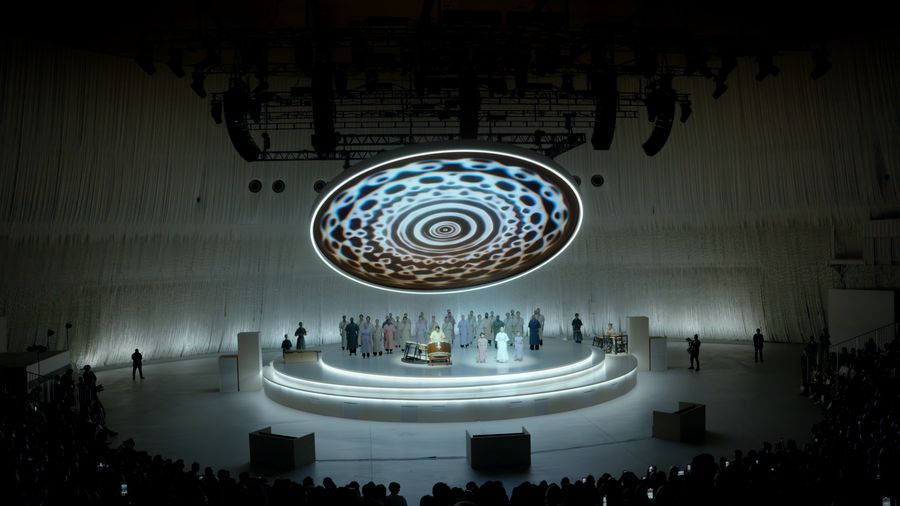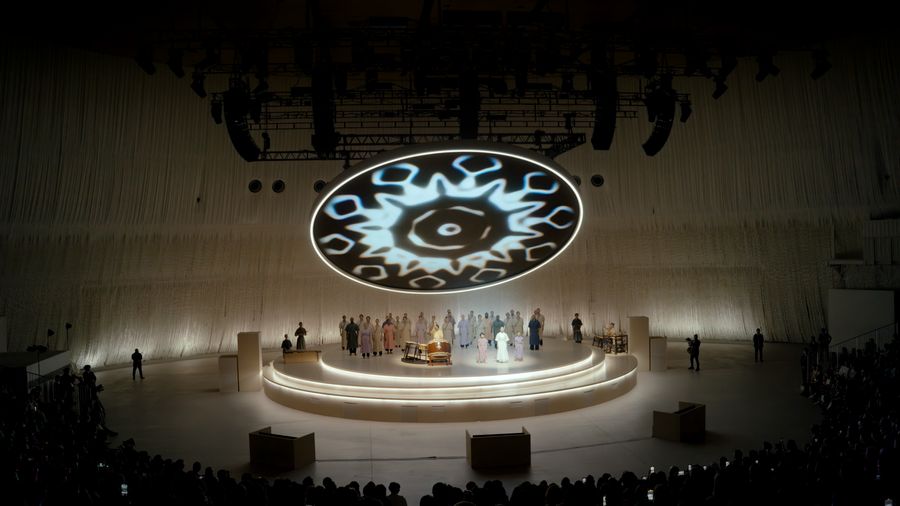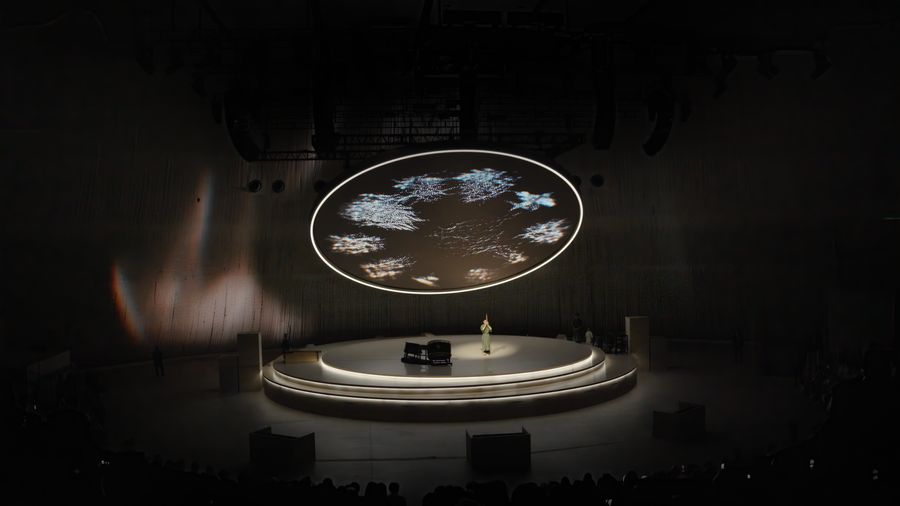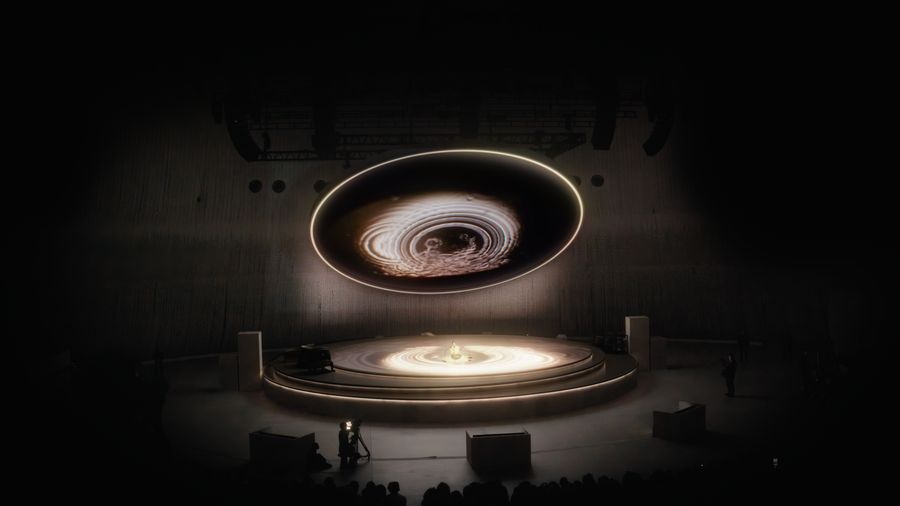Cartier Women's Pavilion Opening Ceremony
FRAY was honoured to be invited to design the video content for the opening ceremony of the Women’s Pavilion at Expo 2025 in Osaka, Japan. Sponsored by Cartier and produced in collaboration with the renowned Es Devlin Studio, the pavilion featured a breathtaking opening ceremony that celebrated creativity, diversity, and global voices.
The concept for the video started with the idea of a drop into still water rippling outward, reflecting the messaging behind the women's pavilion in that ripples from a drop of water can travel, colliding with one another and create something beautiful and impactful.
Concept Development
The Women’s Pavilion was created for Expo 2020 Dubai as a space to celebrate the achievements and voices of women around the world. Es Devlin's 2025 Osaka iteration explores how individual actions, like ripples in water, can come together to create lasting impact.
The concept came to life through Cymatics, where sound vibrations animate a surface into evolving patterns. The drum-like auditorium became a visual instrument, amplifying and reverberating the messages of the World Expo beyond its walls.
The design featured two facing surfaces, a circular floor and ceiling, encouraging a sense of reflection and connection. An early idea of using a real water pond was set aside in favour of creating more dynamic, light-driven effects.
To extend the spatial idea into video, our aim was to evoke the feeling of real rippling water and shifting light. After extensive R&D; using softwares such as, TouchDesigner, Notch, Redshift Caustics and After Effects. It became clear that the richness of movement and light could only be best achieved through a real-world shoot.
The result was a simple yet immersive presentation, one that allowed the performances and talks to resonate at the heart of the Pavilion’s message: small actions can create powerful waves.
In this blogpost we will set out our R&D and process to achieve this look.
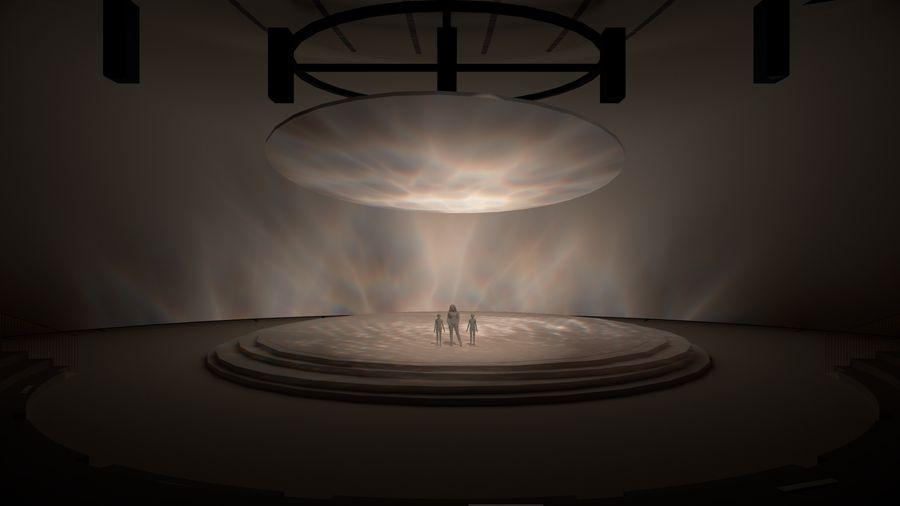
Concept previs to illustrate water ripples and reflections
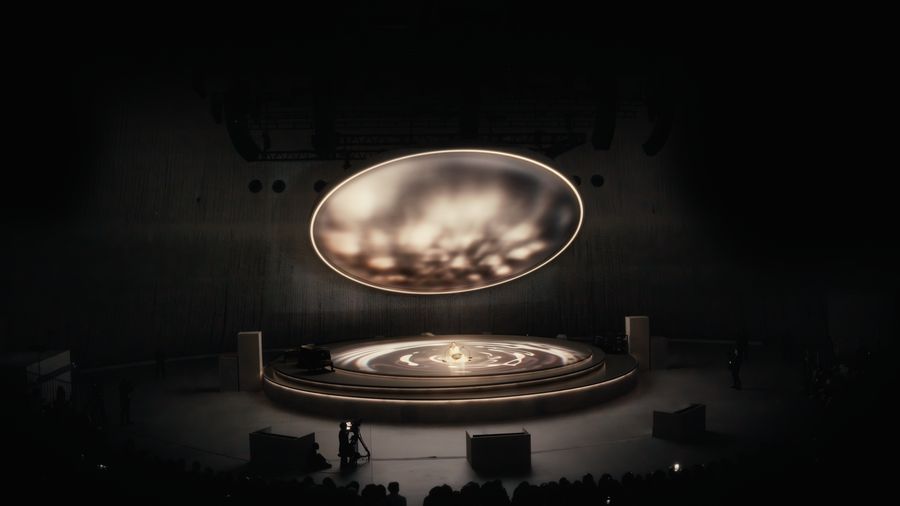
Still from the opening ceremony
R&D
We went through several phases of trial and error in the process of finding a perfect setup. A lot of ink was splashed over several kitchen worktops across FRAY team members.
For the physical set-up, we landed on small plastic screwtop containers hot-glued onto the centre of a fairly cheap speaker, which had a good range from 50 Hz - 60 kHz. We then had a set of containers, from cake pans to scented candle lids, which we could lightly screw onto our containers.
We tested several different liquids and arrived at a medium-concentrated ink solution. This one gave us the most interesting and defined ripples.
After experimenting with recording the ripples at 50-100 frames per second, we realised that those ripples still looked too fast and erratic. We were going to project them across the entire back wall of the auditorium, so a ripple that would take a second to cross the filmed surface of 10cm would, in the final show, cross the distance of 30m. That would be much too fast and distracting rather than meditative. We decided we needed to record at a much higher frame rate of a 1000 frames per second, which led us to choose a Phantom 4K Flex GS High Speed Camera. When shooting at frame rates this high, you quickly realise that we needed much more light. We used a very powerful ring light plus two APUTURE LS 600D PRO DAYLIGHT LEDs. Phantom Hire in Bristol were fantastic in letting us do a day's test at their premises and suggesting we get the talented Ash Farkas (Assistant Camera) in for the test and duration of the shoot. This way, we could focus on the physical set-up and directing the outcome.
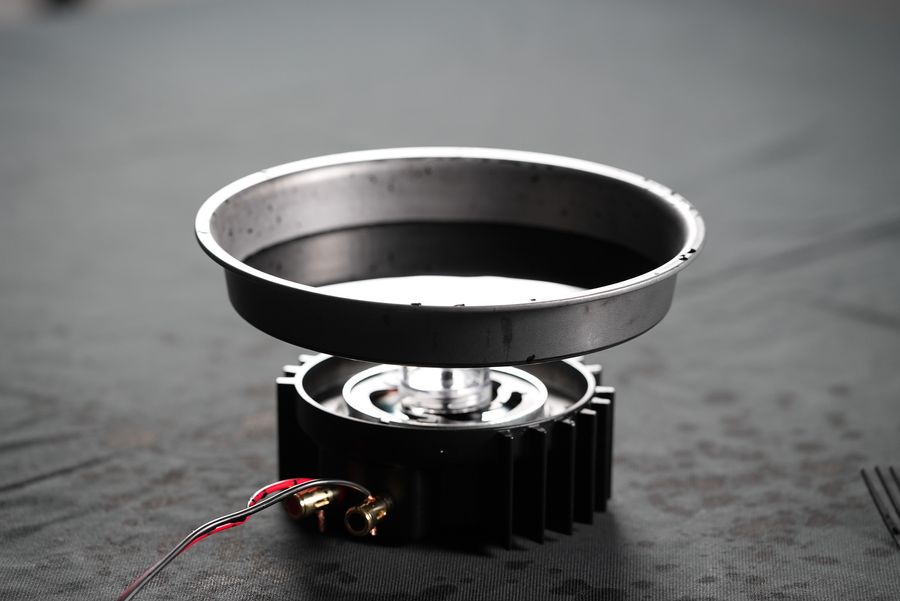
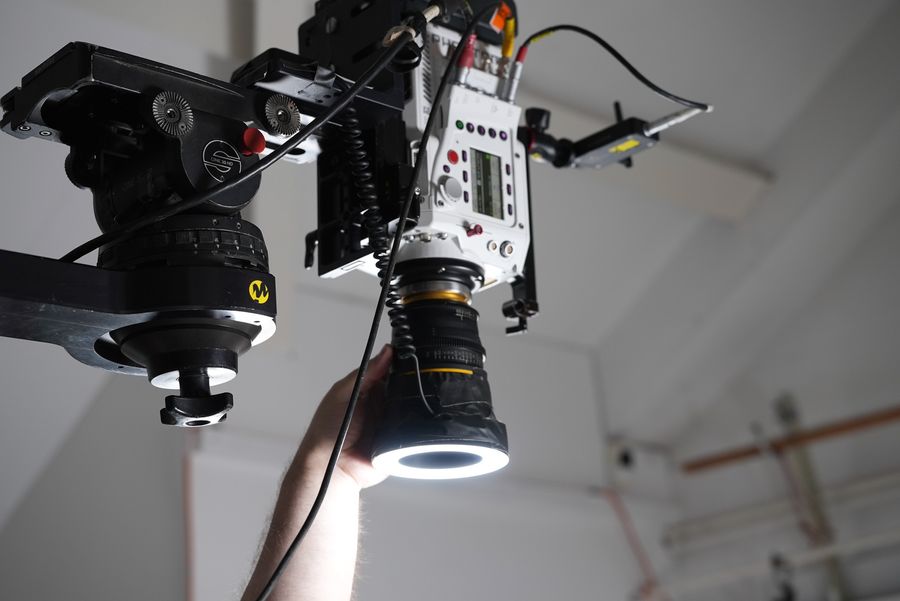
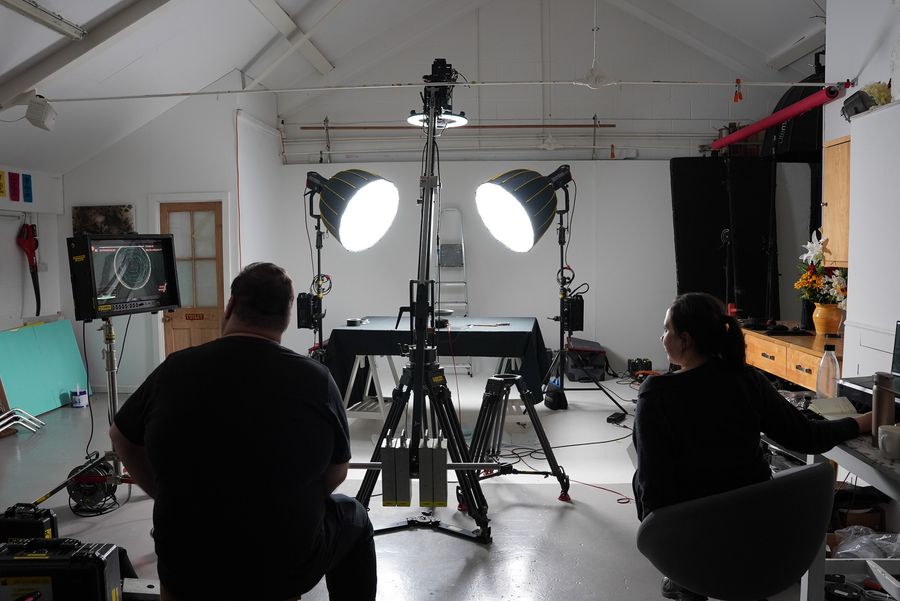
Shoot
The test phase completed we took our set-up and a few boxes of additional arts and crafts materials to a studio in Bath.
The first day was spent using the soundtrack composed by Kieran Brunt to create ripples. As we were going to use the ripples in the final performance, which was designed around this soundtrack, it felt like an obvious choice to start there. We noticed beautiful small ripples appear with different instruments.
Initially, we recorded in real-time. In the end, however, we recorded the most interesting parts of the performance soundtrack at 1000fps, as at scale the movement would have been too fast and jittery. The most interesting part, which made it into the show, was these very fine ripples which were produced by the shō (a Japanese reed-instrument).
Ripples created by the sho instrument playing in the original soundtrack for the finale performance
We then moved on to frequency bands. We quickly realised that the cake pan we were previously using was too big to create interesting, intricate patterns, as the liquid needed to bounce back from the edges. We also found that air bubbles collecting at the edges of the containers ruined all patterns, which led us to move to water with food dye rather than ink. The most interesting patterns appeared at uneven frequencies at very high volumes. This was where we were all grateful for our earplugs.
We had to constantly adjust the volume up and down to hover at the pattern stage. Below and above the sweet spot, the patterns would resolve into ripples or very boring noise.
We spent a few more hours agitating water in probably all ways we could come up with, from a leaf-blower to pipettes of water and spraybottles. Pipetting drops of water exactly into the centre became our money shot for the beginning of the performance, while wiggling a container in a slow rhythm with a small ringlight around the camera gave us our "moon-on-water" effects.
To create the caustic reflections which completed our ambient water look for the auditorium, we first tried to create "real" caustics. We focused as much light as possible on a small spot on the water surface and filmed a white screen above it at 45 degrees. Frustratingly, it did not give us quite the effect we wanted. Filming at a high frame rate, we couldn't get the caustics bright enough, and filming at a lower frame rate, the caustics would be much to fast for projection on a 30x12m surface. In the end, a small display motor rotating a cake pan with crumpled aluminium inside gave us the best caustics we could've asked for and filmed at 300fps, they were the perfect speed.
Animation
After 3 Days of shooting, we had about 18TB of Cinefiles to work through and convert. After working through that and the editing and grading of the footage with DaVinci Resolve, the only difficult part of creating the show was to decide what not to include as everything came out so beautifully.
We created loops of the ripples and caustics for speaker and ambient states. Starting from the "drop in a still pond" brief, our water drops initiated the big finale performance. Each heartbeat in the music became a drop into water, building up to many small ripples and drops across the water's surface. We included the slo-motion filmed ripples created by specific instruments or vocal ranges wherever they appeared, which gave us a fantastic conceptual framework to build around.
The beautiful, inky animals animated by Laura and Ana completed a magical performance which felt like it had all been created on a shimmering water-surface.
Show
Animation in the end took up the smallest part of production. Compared to the time and resources we would have spent on creating this through animation, procedural or not, does not compare to what we dedicated to the shoot and post production. And the outcome has so much more depth and interest than anything we achieved in R&D Animations. We and the client were very happy with how it worked in the space. It really did feel like water and light created the effect in the space.
